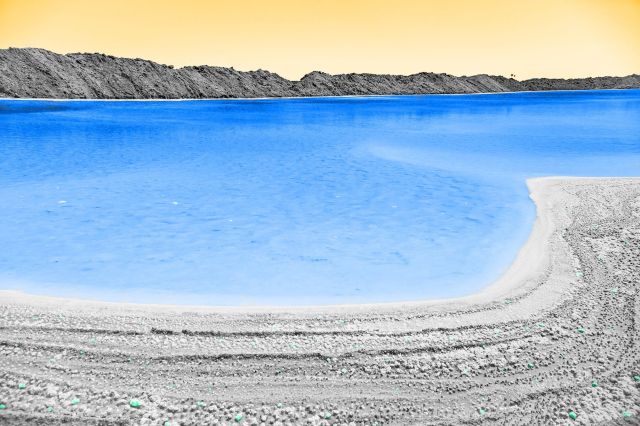
A Colombian City Was Completely Forgotten by Outsiders for 400 Years
For centuries, Ciudad Perdida (“Lost City” in Spanish) — located in the Sierra Nevada de Santa Marta mountains of Colombia — was a thriving urban center for the Tairona people. But the site was mysteriously abandoned after the 16th century, along with any knowledge of its existence as far as the outside world was concerned. Despite a detailed archeological survey of the area, it was a group of treasure hunters who ultimately rediscovered the city in the 1970s.
Archaeologists soon uncovered a vast network of stone structures and tiered terraces, some dating back to the seventh century. Around 80 of the site’s 400 acres are now open to the public, but visiting is no easy feat: It requires a four- to six-day round-trip hike through 30 miles of steep terrain and humid, mosquito-laden tropical forests. Hiring a local guide is required.
While there isn’t vehicle access, the good news is that visitors will find campsites, water stations, and even snack stands (at least one with Wi-Fi) along the way, many run by the Indegenous Kogi people who live in the area. Another upside to the grueling trek? The Sierra Nevada de Santa Marta region is a UNESCO-designated Biosphere Reserve, with a wide variety of flora and fauna, including nearly 630 bird species — many of which you won’t find anywhere else on Earth.

There’s a Space Junk Graveyard in the Remote Pacific Ocean
In 1992, a survey engineer named Hrvoje Lukatela discovered the Oceanic Pole of Inaccessibility, the spot in the ocean farthest away from any land. More familiarly known as Point Nemo, the pole is located nearly 1,700 miles from three roughly equidistant islands: Ducie Island in the Pitcairn Islands to the north, Easter Island to the northeast, and Maher Island in Antarctica to the south. To put its remoteness into perspective, the closest humans to this remote stretch of the Pacific Ocean are those aboard the International Space Station, which orbits about 250 miles above the Earth.
The discovery of Point Nemo didn’t have much usefulness, at least for most people on Earth. Not only is the area extremely difficult to get to, but it’s also within the South Pacific Gyre, a region that resists nutrient-rich waters. Point Nemo is, however, widely used for one purpose: disposing of space junk. Since the 1970s, the South Pacific Gyre has been the preferred spot for the United States, Japan, Russia, and several countries in Europe to drop their decommissioned equipment, since debris is less likely to hit the human population. When the International Space Station is retired in 2030, it will join more than 200 abandoned pieces of space equipment surrounding Point Nemo.

There’s Another North Pole — And It’s Even Harder to Visit
There’s the geographic North Pole, which is the northernmost point of the Earth’s axis of rotation, and then there’s the Northern Pole of Inaccessibility, a spot at the center of vast ice fields about 400 miles away from the geographic North Pole. Similar to the Oceanic Pole of Inaccessibility, this is the point in the Arctic Ocean that is farthest away from the nearest landmass.
Despite being first discovered in 1909, nobody has actually managed to reach the Northern Pole of Inaccessibility in the past 100-plus years — although the most intrepid adventurers keep trying. Making matters more complicated: The pole is also a moving target, shifting around as new islands are discovered, and researchers anticipate more movement due to rising sea levels.
A British team led by explorer Jim McNeill has made several attempts to reach the pole over the last two decades. However, they have faced numerous challenges: A 2003 mission never left basecamp after McNeill fell ill with a flesh-eating bacterial infection, and in 2006, McNeill made it 168 miles away from land before falling through disintegrating ice, forcing the team to retreat. The team’s most recent attempt was in 2019.
The Southern Pole of Inaccessibility, the corresponding point in Antarctica farthest from the nearest landmass in the Southern Ocean, has proved to be much more accessible. In the late 1950s, the Soviet Union built a meteorological research station there, along with a bust of Vladimir Lenin to mark the exact spot.
More Interesting Reads

St. Helena Island Is Home to the World’s Oldest Tortoise
St. Helena — a remote British Overseas Territory in the South Atlantic best known as the location of Napoleon’s final exile in 1815 — has another (more current) claim to fame: Jonathan, a Seychelles tortoise who is Earth’s oldest known living land animal, according to the Guinness Book of World Records. Now believed to be 190 years old, Jonathan was at least 50 years old when he was gifted to Sir William Grey-Wilson, a future governor of the island, in 1882. He still lives at the governor’s residence (31 governors later), along with fellow giant tortoises Emma, David, and Fred.
“While wars, famines, plagues, kings and queens, and even nations have come and gone, he has pottered on, totally oblivious to the passage of time,” Joe Hollis, Jonathan’s caregiver told the Washington Post in early 2022. Tortoises were a popular diplomatic gift at the time because they were easy to transport, since they were stackable and could go without food and water for an extended period. They were also considered a delicacy — a fate which Jonathan fortunately avoided.
It’s much easier to get to St. Helena than it was in Napoleon’s time, but it’s still fairly difficult. One of the most remote inhabited islands in the world, St. Helena is located about 1,200 miles west of Angola and 2,500 miles east of Brazil. Until 2017, visitors needed to board a five-day boat trip from South Africa, but with the opening of the island’s first airport, you can now catch the six-hour flight from Johannesburg every other Saturday.

The Planet’s Smallest Flightless Bird Is Endemic to a Tiny, Remote Island
About 1,300 miles south of St. Helena, the island of Tristan da Cunha is also a British Overseas Territory, but much more difficult to reach. While St. Helena now has an airport, visiting Tristan da Cunha still requires a weeklong ocean journey from Cape Town (which can sometimes take even longer, depending on the weather). Tourists also need permission from the Island Council to visit.
“Tristan da Cunha” also refers to a group of islands. About 25 miles off the southwest coast of the island of Tristan da Cunha is the aptly named Inaccessible Island. Totaling just 5.4 square miles, the tiny island is surrounded by steep cliffs, making it difficult to even land a small boat there. That has resulted in a uniquely pristine ecosystem, which has allowed the world’s smallest extant flightless bird, the Inaccessible Island rail, to evolve and thrive. (At only about 5 or 6 inches big, it’s a little smaller than a dollar bill.) Current estimates place the island’s population around at least 9,000 birds.
The Inaccessible Island rail’s closest relatives are two South American bird species that are able to fly, but when their common ancestor landed on the island, it evolved in an entirely different direction. The birds developed longer bills and sturdier legs, and their wings turned stubby, with much smaller feathers. Since the birds could get most of their prey on the ground — such as moths, seeds, berries, and worms — and predators were scarce, flying became less of a priority. The island doesn’t even have any mice or rats that could pose a risk to chicks.

Australia’s Tallest Mountain Is a Remote Volcano Named Big Ben
Located in the Southern Ocean about 2,500 miles southwest of Perth, Heard Island is home to one of Australia’s two active volcanoes and the country’s only glaciers. If you thought the sea journey to Inaccessible Island was arduous, expect a journey to this remote spot to take two weeks, depending on weather, through notoriously rough waters.
While 7,310-foot Mount Kosciuszko is the tallest mountain on the Australian mainland, Big Ben, covering much of Heard Island, is the country’s tallest mountain overall — over 9,000 feet above sea level. Because of the remote location and harsh conditions, very few people have attempted to summit Big Ben. Only three parties have ever completed the ascent: two expedition groups in 1965 and 1983, and one mountaineering club associated with the Australian Army in 1999/2000.
Not only is the journey to reach Heard Island lengthy, but actually landing a vessel there is also quite challenging. For this reason, few tourist groups visit the island. Most visitors are researchers in fields such as volcanology, ecology, and oceanography, along with environmental management organizations.

The World’s Northernmost Settlement Requires Radio Silence
With a latitude of 78.55 degrees north, Ny-lesund, Norway, is the world’s northernmost year-round settlement, located just north of Longyearbyen, in the Svalbard archipelago. The town is home to approximately 40 permanent residents, who can send mail from the world’s northernmost post office.
While Ny-Ålesund does welcome visitors, there are some unique rules tourists must follow. The most important of these is to turn off Wi-Fi and Bluetooth on all devices. The former mining town, established in 1916 and still owned by the King’s Bay mining company, has doubled as a research station since the 1960s, and surrounding it are finely tuned instruments that measure the Earth’s slightest movements. As smartphones can interfere with their measurements, visitors must observe radio silence while visiting. They should also avoid approaching the town’s dog yard; the dogs here are trained to alert the town at the first whiff of a polar bear (although you can observe them from a safe distance).
Ny-Ålesund doesn’t have overnight accommodations for tourists, but it does offer a free museum and the world’s northernmost gift shop, along with many cultural artifacts, including remnants of the mining town, and stunning glacier views.
The town is part of the icy Svalbard archipelago, known for its five-month-long polar night and excellent opportunities to view the northern lights. Most visitors stay in Longyearbyen, which has a significantly higher population of about 2,400, along with schools, churches, a grocery store, and a few breweries. Longbearyen also offers various lodging options, from luxury hotels to remote cabins. However, visiting can be logistically challenging — flights typically run to Longyearbyen from Oslo only three days per week, and flights from there to Ny Alesund run twice weekly.

A Remote Egyptian Oasis Has Its Own Language
To reach the Siwa Oasis and its 200 springs and thousands of palm and olive trees, you’ll have to travel 350 miles through the desert southwest of Cairo, Egypt. Despite Siwa being a well-established — albeit somewhat hard to reach — tourism destination, the culture and language that evolved in this isolated location is dominant among the local Berber peoples. Around 20,000 people speak the Siwi language, a dialect of the Tamazight language spoken across North Africa, and it is much more common in homes than Arabic. However, Siwa is not taught in schools, to the concern of Siwa residents and language preservationists. (The U.N. has also classified the language as “endangered.”)
It can take up to 12 hours to reach the Siwa Oasis by car or bus from Cairo, or three hours from the nearest Egyptian airport, Mersa Matruh. There’s plenty to see once you arrive: Cleopatra’s Spring, a large stone pool with surrounding cafes, is the most famous of the many springs in the oasis. The remains of the Temple of the Oracle, built in the sixth century BCE, are also a must-see. Visitors can rent bikes or even go sandboarding on the surrounding dunes.












